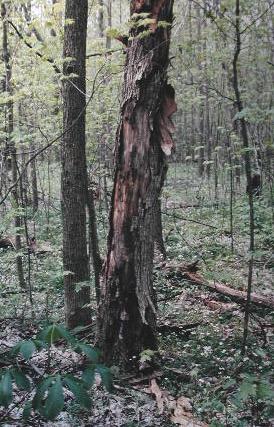| 03-29-04
The early part of the spring migration of birds is only the tip of the
iceberg, but in the last two days (Saturday and Sunday) I had the opportunity
for lengthy studies of two of the most interesting and beautiful migrants.
First, my ground feeding station (outside the double glass doors of
my work room) lured in a pair of fox sparrows. And while I knew I could
not photograph them through the window even at close range, I could watch
them for at least an hour.
I do not see fox sparrows at point-blank range every week, month, year--possibly
even decade--but we both like the same living conditions (thick cover).
And when our paths cross at close quarters, I consider myself the luckiest
man on earth.
As I hammered away at my old computer, my eyes caught movement in the
cover of dead leaves under the hedge just outside my double glass doors.
The monitor of the computer and its tower (I think they call it) hide
my movement from the birds, but I have a relatively clear view (depending
on the amount of spider "webbery" and other items that collect on windows)
of the proceedings out there.
The hedge under which I feed birds (protection from the resident cooper's
and sharp-shinned hawks) is roughly 25 feet long and 10 feet wide. There
is a thick cover of dry leaves under the hedge because I figure it keeps
my guests happy while they dine.
My eyes caught movement, though, and while I could not identify this
critter immediately, I ignored the thing I was trying to write and focused
on the movement. When Mr. Fox Sparrow hopped into view, I was glad I did.
The rich brown outer tail feathers of the male identified him immediately
as a fox sparrow (Passerella iliaca). Aside from those gorgeous
(almost orange) outer tail feathers, his dark-streaked breast and bulky
stature (compared to other sparrows) held my attention.
None of my bird guides give the female of the species a call, but if
my observations can be held reliable, I thought she was typical of females
of the sparrow ilk: rather dull, with a plain gray breast. To sooth the
feelings of female sparrows, I might add that she probably is a very good
housekeeper and doting mother.
If the female was something less than spectacular to look at, she was
always very close . . . seemingly very loyal . . . to her mate. And they
both "hopscotched" with both feet to rake the dry leaves away from the
sunflower seed and corn that is always there. The fact that both male and
female used the forward-backwards shuffle with both feet to scratch up
food convinced me that they were mated.
A day later--on that beautiful, 80-degree Sunday morning--I am resting
between chores on the top deck of my stairway down to White River, when
a bird zips into one of the little sugar maple trees 20 feet from my resting
spot.
"Woodpecker . . . probably downy or hairy," I tell myself, but in the
back of my mind I know the sapsuckers (Sphyrapicus varius) should
be back in town because the maples are weeping from the holes they drilled
last year.
And sure enough, when the bird flips around to my side of the little
maple, the white throat tells me it is the female of the species. The elongated
white bar on the wing tells me it definitely is a sapsucker. She somewhat
resembles a miniature pileated woodpecker.
I will see the sapsuckers often as the sap rises in the sugar maples,
and now and then throughout the summer.
MOREL MADNESS
"Hello! Bill, When do they start? Where can I get them? I'm crazy over
them . . . Is there a map to tell me where to get them?
"Any Help please!!!!!!! Thanks, Bob."
In case you are wondering, the object of Bob's enthusiasm is spring
morels. A good part of the mail we get and telephone calls at this time
of year involves mushroom hunting.
Our educated guess: Last Sunday's 80-degree temp coupled with bright
sunshine, may have caused a few dry leaves to tremble ever so slightly
. . . more of the same, coupled with some showers--or even heavy rains--will
launch it . . . the spring morel season.
In the early going, look on wooded hillsides that face south, but don't
be surprised at finding small grays and waxy caps any place. Remember,
mushrooms (like other wild things) are where you find them.
The best indicator I know is spring beauty . . . when spring beauty
blooms it is time to start looking for morels. When lilacs bloom, big yallers
should be up. Find paw-paw saplings in bloom and you will find morels .
. . if bloodroot and adder's tongue are displaying seed ponds, the end
is nigh . . .
My best morel-hunting advice is found in a folder of my computer labeled
"Wish I had written that":
The thing that you've got to remember
About mushroom hunting is that:
There ain't no point in lookin'
Until you're where they're at.
Thank you, Chuck Weatherwax, the late mushroom-hunting sage of
Bloomington.
 |
You
will have a shot at being where the mushrooms "are at" around dead elm
trees (bark slipping) like this one. |
|

